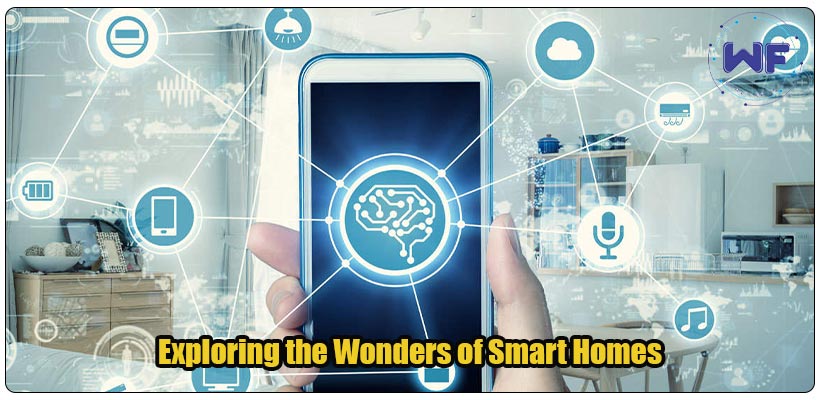In recent years, the concept of a smart home has gained significant traction, transforming the way we live and interact with our living spaces. With advancements in technology and the Internet of Things (IoT), homeowners now have the ability to control and automate various aspects of their homes, creating a more convenient, efficient, and connected living environment. This article delves into the fascinating world of smart homes, exploring their benefits, components, and the future they hold.
1. What is a Smart Home?
A smart home refers to a residence that incorporates various automated systems and devices that can be controlled remotely or autonomously. These systems are interconnected through a central hub or a network, enabling homeowners to monitor, manage, and interact with their homes using smartphones, voice commands, or dedicated applications.
2. Benefits of Smart Homes:
a. Enhanced Convenience: Smart homes offer unparalleled convenience by automating routine tasks such as lighting, temperature control, and security. Homeowners can control various aspects of their homes with a simple voice command or a tap on their smartphones.
b. Energy Efficiency: Smart home technologies enable optimized energy usage by automatically adjusting lighting, heating, and cooling based on occupancy or predetermined schedules. This leads to reduced energy consumption and lower utility bills.
c. Improved Security: Smart security systems provide enhanced protection through features like smart locks, video doorbells, and motion sensors. Homeowners can remotely monitor their property, receive real-time alerts, and even grant access to visitors from anywhere.
d. Remote Monitoring: Smart homes allow remote monitoring of appliances, security cameras, and other devices. This feature enables homeowners to keep an eye on their homes and receive notifications in case of emergencies or unusual events.
e. Personalization and Comfort: Smart homes can adapt to individual preferences, creating personalized and comfortable living environments. From adjusting lighting to playing music or setting the perfect temperature, smart home systems cater to homeowners’ unique needs.
3. Key Components of a Smart Home:
a. Smart Hubs: These act as the central command centers, connecting and controlling various smart devices and systems within the home.
b. Smart Lighting: Intelligent lighting systems can be remotely controlled, automated, and even adjusted based on natural light or occupancy.
c. Smart Thermostats: These devices optimize energy usage by learning temperature preferences and adjusting heating or cooling accordingly.
d. Smart Security Systems: Smart security cameras, door locks, and sensors provide enhanced security and allow homeowners to monitor their homes remotely.
e. Voice Assistants: Popular voice assistants like Amazon Alexa or Google Assistant enable hands-free control and interaction with smart devices through voice commands.
4. The Future of Smart Homes:
The smart home industry continues to evolve, and the possibilities are endless. Some exciting advancements on the horizon include:
a. Integration of Artificial Intelligence (AI) for smarter automation and predictive capabilities.
b. Further expansion of IoT devices, connecting appliances, wearables, and even vehicles to create a seamless smart ecosystem.
c. Enhanced interoperability and standardization, allowing different smart devices from various manufacturers to communicate and work together seamlessly.
advantages of having a smart home:
1. Enhanced Convenience:
One of the primary benefits of a smart home is the convenience it provides. With smart devices and automation systems, you can control and manage various aspects of your home with ease. Whether it’s adjusting the lighting, controlling the thermostat, or even locking your doors, you can do it all remotely through a smartphone app or with voice commands.
2. Energy Efficiency:
Smart homes promote energy efficiency by optimizing the usage of utilities. Smart thermostats, for example, can learn your temperature preferences and automatically adjust the heating and cooling based on occupancy and weather conditions. Smart lighting systems can be programmed to turn on and off based on your presence, natural light, or specific schedules, reducing energy waste.
3. Increased Home Security:
Smart home security systems provide enhanced protection and peace of mind. With features like smart locks, video doorbells, and motion sensors, you can monitor your home remotely and receive real-time alerts about any suspicious activities. You can also grant access to visitors remotely, ensuring that your home remains secure even when you’re away.
4. Remote Monitoring and Control:
Smart homes allow you to monitor and control your devices and appliances remotely. Whether you want to check if you left the lights on, adjust the temperature before you arrive home, or monitor security cameras, you can do so from anywhere using your smartphone or other connected devices.
5. Personalization and Comfort:
Smart home technology allows you to personalize your living environment according to your preferences and needs. You can create customized settings for lighting, temperature, and entertainment systems to match your mood or desired ambiance. Voice assistants, such as Amazon Alexa or Google Assistant, further enhance comfort by allowing you to control devices and systems through simple voice commands.
6. Improved Safety and Emergency Response:
Smart home systems can detect and respond to potential dangers, such as fire or carbon monoxide leaks. They can trigger alarms, notify emergency services, and even shut off utilities to mitigate risks. This proactive approach to safety helps protect your home and loved ones.
7. Integration and Automation:
Smart home devices can be integrated and automated to work together seamlessly. For example, you can set up “scenes” where multiple devices adjust simultaneously. A “movie night” scene could dim the lights, close the curtains, and turn on the home theater system with a single command.
8. Accessibility and Aging in Place:
Smart home technology can greatly benefit individuals with mobility issues or those who wish to age in place. With voice control and automation, tasks become easier to manage, and remote monitoring allows caregivers or family members to keep an eye on their loved ones.
Conclusion:
Smart homes have revolutionized the way we interact with our living spaces, offering convenience, energy efficiency, and enhanced security. With advancements in technology and the increasing adoption of IoT, smart homes are poised to become more sophisticated and accessible. By embracing these innovative solutions, homeowners can create a connected living environment that simplifies daily life, promotes energy conservation, and provides peace of mind. As we move forward, the future of smart homes holds immense potential to transform our lifestyles and enhance our overall well-being.
These benefits showcase the transformative potential of smart homes, offering convenience, energy efficiency, enhanced security, and personalized living experiences. As technology advances, the range of benefits is expected to expand, making smart homes an increasingly attractive option for homeowners.



4 Responses
Thank you
Wirefaren
You’re Welcome
erfan
Very good 👍👍👍
You’re Welcome